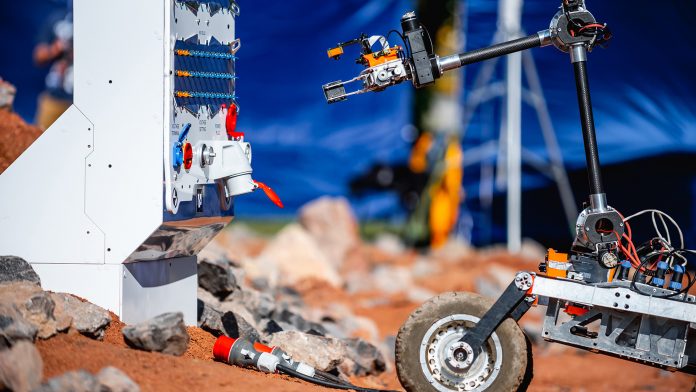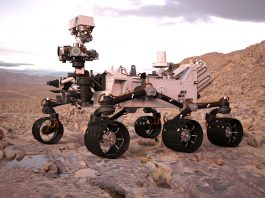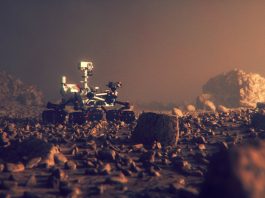Agnieszka Mrozowska discusses the highlights of the ERC 2020 competition, which involved Innovation News Network as a media partner, holding it up as an example of how the space sector can adapt to the new reality
In March 2020, NASA’s Mars Science Laboratory (MSL) mission team entirely remotely commanded the Curiosity rover to gather samples at the drill hole target called ‘Edinburgh’. Nobody could have predicted that six months later, hundreds of young engineers from all around the world would experience the very similar challenge of remotely navigating a mobile robot. The only difference was that the rover controlled by the finalists of the ERC 2020 competition was not operating on the surface of the Red Planet but on the biggest artificial Martian field in the world in Kielce, Poland. The MarsYard is a 1,200m2 area designed to resemble the Jezero Crater, the exact location of the planned landing of NASA’s Perseverance rover in 2021.
The ERC Space and Robotics Event is an international mobile rover competition organised in the very centre of Europe for the past six years. Over 60 teams from across five continents submitted their applications to take part in this year’s edition of the tournament. Based on the technical documentation received in the second stage of the competition, jurors chose 33 teams from 14 countries to enter the finale, which took place on 11-13 September.
The COVID-19 context
In the previous editions of the ERC, university teams of young and ambitious engineers worked for several months to build a fully-operational Martian rover. They then travelled to Poland to participate in the four field tasks. Lucas Wilczynski, the founder and main organiser of the ERC competition, has explained that it became clear very early on that the rules for ERC 2020 needed to change if this year’s event was to take place because of the restrictions in place as a result of COVID-19.
He said: “Teams were concerned they would not be able to finish their rovers on time due to closed universities and laboratories. Many of them worried about losing their sponsors and not having money to travel to Poland. Moreover, we were not sure if anybody would even be able to enter the country in September. Enabling engineers from all around the world to take part in this year’s competition quickly became our number one priority. That is why we decided to organise the sixth edition of the ERC in a new, hybrid formula.”
This meant that, for the first time in the history of ERC and the Rover Challenge Series, the participants remained in their home countries during the finale and performed the field tasks remotely. To make that shift technically possible, the ERC 2020 competition organisers teamed up with prestigious institutions and creative start-ups. Poznan Supercomputing and Networking Center (PSNC), along with the High-Performance Computing Center and the national broadband network PIONIER, were all responsible for a sustained internet signal and the high data transfer rate. Freedom Robotics, an American start-up from Silicon Valley, delivered an innovative remote robot management platform. This platform, combined with small and agile mobile rovers designed by a Polish company, Kell Ideas, paved the way for the teams to participate in the competition 100% remotely.
The remote robot management platform
Adapting Freedom Robotics’s system to the needs of ERC 2020 necessitated the creation of a very detailed graphic projection of the robots the teams would use during the finale of the competition at the MarsYard. Once adjusted, the platform was opened to the teams, which had one month to run simulations and prepare their own software including algorithms to allow the rover to move independently.
Wilczynski said: “The remote edition of our competition completely shifted our focus from hardware skills, such as building your own robot, to software development and incorporating an increasing amount of autonomy in the teams’ projects. Most of this year’s participants accepted the new goals and regulations with enthusiasm, seeing them as a great opportunity to develop new skills that perfectly fit into the requirements of modern space and robotics programmes.”
The competition
The ERC 2020 competition three-day finale started early on the morning of 11 September. The first team to connect with the MarsYard in Poland was DJS Antariksh from the Dwarkadas J. Sanghvi College of Engineering in Mumbai. At 08.00 sharp, they started the first field task, ‘ Navigation/Science’. Their job was to navigate the rover to reach six landmarks on the field using only their coordinates and aerial photos of the MarsYard, both of which had been received prior to the competition. Time was one of the elements assessed during that task, as each team had only 45 minutes to reach all markers. Proximity to the landmarks also played a vital role is assessing the effectiveness of the rovers and their teams.
The scientific aspect of this task involved a meticulous examination of the MarsYard photos. The teams had to count for the unusual geological forms on the simulated Martian surface whose existence would be verified by the rover itself. This method of exploration, based on a remote analysis of the terrain, is called ‘opportunistic rover science’ and is universally used in real-life rover missions. The teams had a chance to demonstrate their resourcefulness and score additional points.
The ERC 2020 field tasks were being conducted simultaneously. While one team struggled to navigate the rover across the MarsYard, another would be attempting the ‘Maintenance’ task, performing repair and service duties at the target machine using a remotely controlled robotic arm. As the competition organisers had previously indicated, the idea here was to concentrate on developing the skills required to work on a new generation of mobile robots, as in the future such machines will be designed to perform increasingly complex tasks. In the space sector, such robots will potentially include rovers equipped with a manipulator and will be used to accompany an astronaut and supporting him in his daily duties, e.g. servicing the machine on a foreign planet outside of the habitat.
Ground-based applications
Such robots can also be useful on Earth, as Wilczynski explained by referring to the publication Next Generation: rover, which was published by the organisers of the ERC competition in 2019. Within this title, they asked the representatives from the worlds of business and science operating in the space sector what the tasks of the next generation of rovers on Mars, the Moon and Earth would be. Most of these experts mentioned using robots in harsh environments where people cannot or should not go because of the danger to their health or lives. Such environments include chemically contaminated areas, the deep-sea region, and disaster response and recovery operations, where rovers can move quickly and more effectively than humans. However, Wilczynski has also pointed out that in order to increase the use of the robots in hazardous situations, the machines must become more reliable and resilient so that they can operate continuously even with a temporary or permanent loss of communication with the control and navigation centre. He said: “ This is a big challenge, to which there is only one answer: autonomy. That is why we pay more and more attention to the innovative aspects of the teams’ projects, promoting those participants who focus on autonomous solutions in their concepts.”
The winner
The winning team of the ERC 2020 remote edition was the ERIG e.V team from Germany. Students from the Technical University of Braunschweig outclassed the competition, scoring 440 out of a possible 660 points. As they admitted after the announcement of the results, winning the competition was the result of several weeks spent on refining the software being developed, testing mission scenarios, and running an endless number of simulations.
Hot on their heels was the Czech team RoverOva which, since its debut at ERC 2018, has been consistently rising through the ranks. For the first time in ERC history, third place was jointly awarded to two teams: Indian DJS Antariksh, and Robocol from Colombia. This year, the organisers also prepared a number of additional awards to recognise the various teams’ efforts for the best scientific mission plan, the most autonomous ride on the Martian track, and the robotic project best presented to the jury panel.
In addition to the mobile rover competition, ERC 2020 also included a ‘Science and Technological Show Zone’, which was open to the public, as well a business conference combining interviews with special guests both online and offline. Thanks to this innovative formula, this year’s list of speakers included great representatives from the international space sector such as Douglas Terrier (Chief Technologist at NASA), Pete Worden (former director of NASA Ames and head of the Breakthrough Prize Foundation), and Louise Hamlin (an engineer at NASA’s JPL research centre).
Agnieszka Mrozowska
The ERC Space and Robotics Event
+ 48 666 300 051
a.mrozowska@planetpartners.pl
Tweet @rover_challenge
Please note, this article will also appear in the fourth edition of our new quarterly publication.









